steering wheel FORD E SERIES 2016 4.G Owners Manual
[x] Cancel search | Manufacturer: FORD, Model Year: 2016, Model line: E SERIES, Model: FORD E SERIES 2016 4.GPages: 319, PDF Size: 6.18 MB
Page 4 of 319
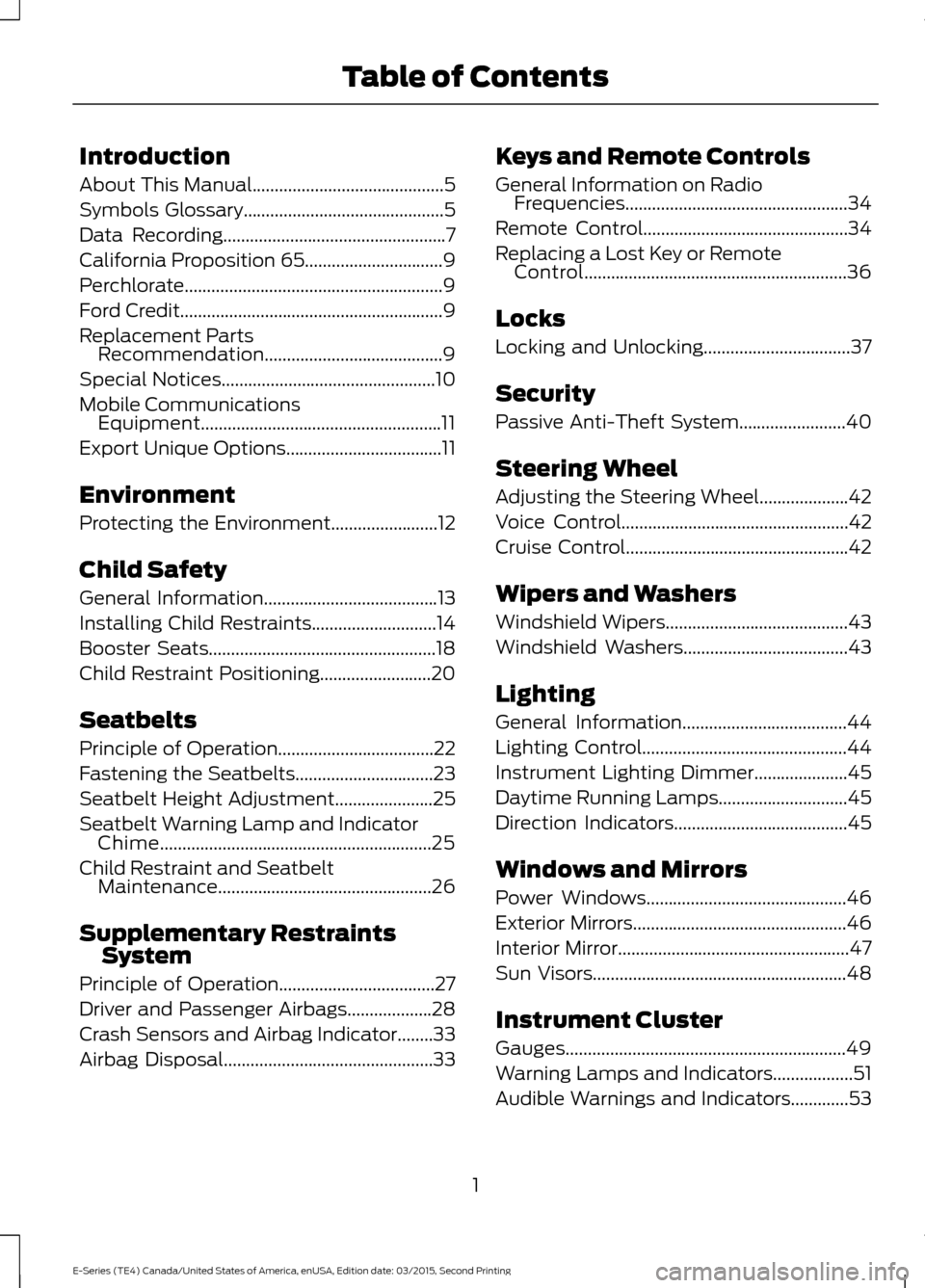
Introduction
About This Manual...........................................5
Symbols Glossary.............................................5
Data Recording..................................................7
California Proposition 65...............................9
Perchlorate..........................................................9
Ford Credit
...........................................................9
Replacement Parts Recommendation........................................9
Special Notices
................................................10
Mobile Communications Equipment......................................................11
Export Unique Options...................................11
Environment
Protecting the Environment
........................12
Child Safety
General Information
.......................................13
Installing Child Restraints............................14
Booster Seats
...................................................18
Child Restraint Positioning.........................20
Seatbelts
Principle of Operation...................................22
Fastening the Seatbelts...............................23
Seatbelt Height Adjustment......................25
Seatbelt Warning Lamp and Indicator Chime.............................................................25
Child Restraint and Seatbelt Maintenance................................................26
Supplementary Restraints System
Principle of Operation...................................27
Driver and Passenger Airbags...................28
Crash Sensors and Airbag Indicator........33
Airbag Disposal
...............................................33 Keys and Remote Controls
General Information on Radio
Frequencies..................................................34
Remote Control..............................................34
Replacing a Lost Key or Remote Control
...........................................................36
Locks
Locking and Unlocking
.................................37
Security
Passive Anti-Theft System........................40
Steering Wheel
Adjusting the Steering Wheel....................42
Voice Control
...................................................42
Cruise Control..................................................42
Wipers and Washers
Windshield Wipers
.........................................43
Windshield Washers
.....................................43
Lighting
General Information
.....................................44
Lighting Control
..............................................44
Instrument Lighting Dimmer
.....................45
Daytime Running Lamps.............................45
Direction Indicators.......................................45
Windows and Mirrors
Power Windows.............................................46
Exterior Mirrors................................................46
Interior Mirror
....................................................47
Sun Visors
.........................................................48
Instrument Cluster
Gauges...............................................................49
Warning Lamps and Indicators..................51
Audible Warnings and Indicators.............53
1
E-Series (TE4) Canada/United States of America, enUSA, Edition date: 03/2015, Second Printing Table of Contents
Page 5 of 319
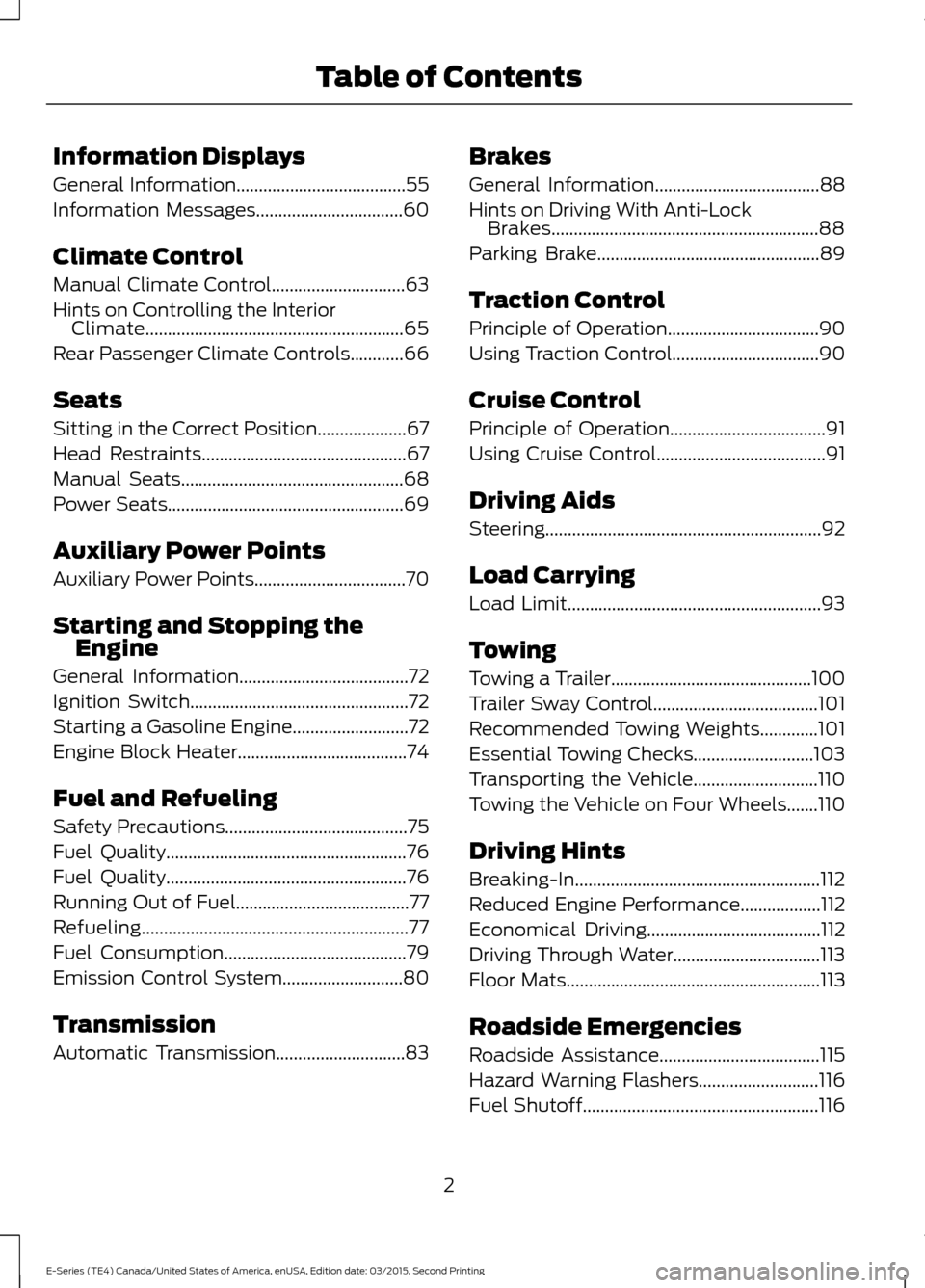
Information Displays
General Information......................................55
Information Messages
.................................60
Climate Control
Manual Climate Control..............................63
Hints on Controlling the Interior Climate..........................................................65
Rear Passenger Climate Controls
............66
Seats
Sitting in the Correct Position....................67
Head Restraints
..............................................67
Manual Seats
..................................................68
Power Seats
.....................................................69
Auxiliary Power Points
Auxiliary Power Points..................................70
Starting and Stopping the Engine
General Information
......................................72
Ignition Switch
.................................................72
Starting a Gasoline Engine..........................72
Engine Block Heater......................................74
Fuel and Refueling
Safety Precautions
.........................................75
Fuel Quality
......................................................76
Fuel Quality
......................................................76
Running Out of Fuel.......................................77
Refueling............................................................77
Fuel Consumption
.........................................79
Emission Control System...........................80
Transmission
Automatic Transmission
.............................83 Brakes
General Information
.....................................88
Hints on Driving With Anti-Lock Brakes............................................................88
Parking Brake
..................................................89
Traction Control
Principle of Operation..................................90
Using Traction Control.................................90
Cruise Control
Principle of Operation...................................91
Using Cruise Control
......................................91
Driving Aids
Steering..............................................................92
Load Carrying
Load Limit.........................................................93
Towing
Towing a Trailer.............................................100
Trailer Sway Control.....................................101
Recommended Towing Weights.............101
Essential Towing Checks...........................103
Transporting the Vehicle............................110
Towing the Vehicle on Four Wheels.......110
Driving Hints
Breaking-In.......................................................112
Reduced Engine Performance..................112
Economical Driving
.......................................112
Driving Through Water.................................113
Floor Mats
.........................................................113
Roadside Emergencies
Roadside Assistance
....................................115
Hazard Warning Flashers
...........................116
Fuel Shutoff
.....................................................116
2
E-Series (TE4) Canada/United States of America, enUSA, Edition date: 03/2015, Second Printing Table of Contents
Page 6 of 319
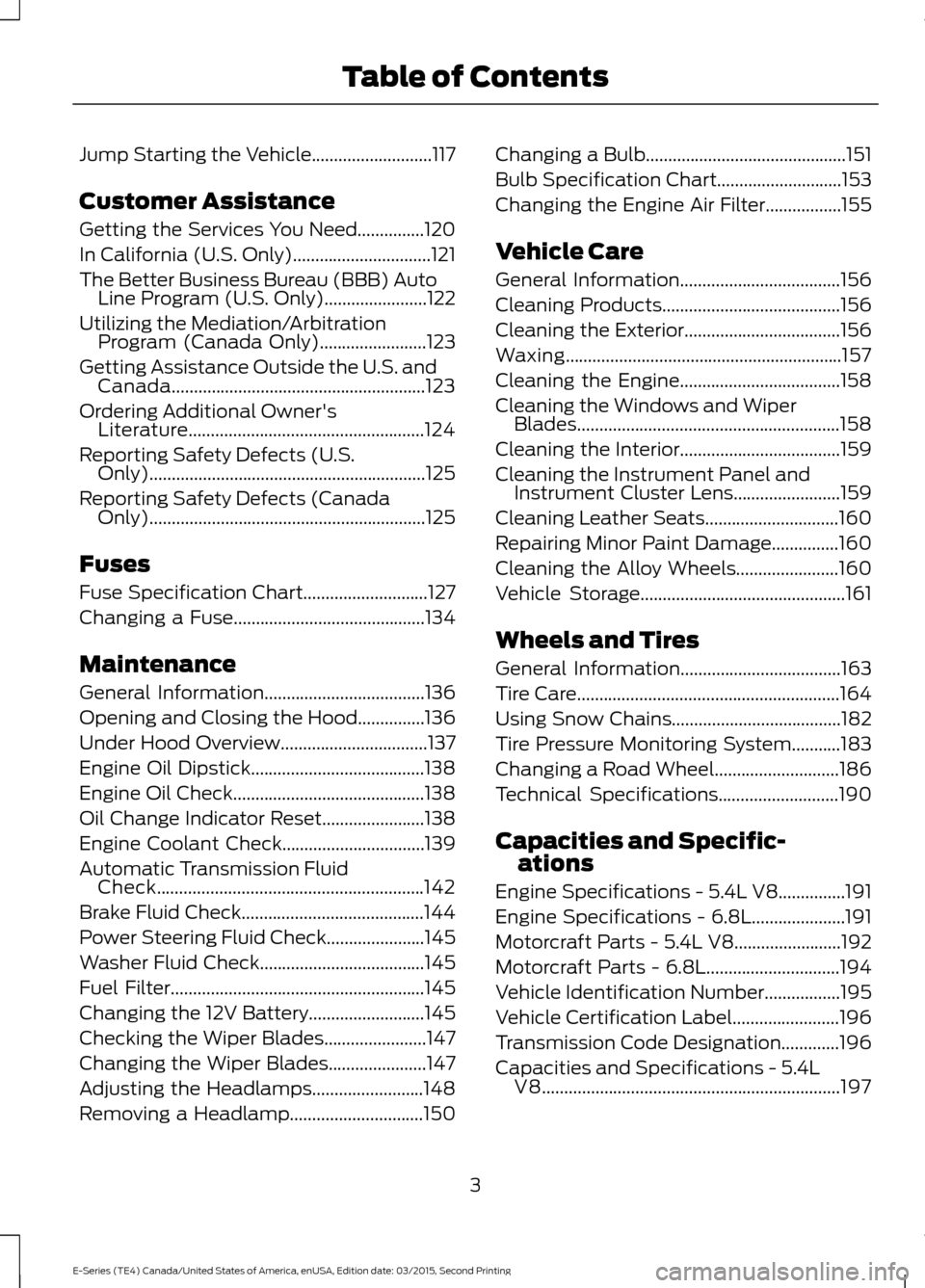
Jump Starting the Vehicle...........................117
Customer Assistance
Getting the Services You Need...............120
In California (U.S. Only)...............................121
The Better Business Bureau (BBB) Auto
Line Program (U.S. Only).......................122
Utilizing the Mediation/Arbitration Program (Canada Only)........................123
Getting Assistance Outside the U.S. and Canada.........................................................123
Ordering Additional Owner's Literature.....................................................124
Reporting Safety Defects (U.S. Only)..............................................................125
Reporting Safety Defects (Canada Only)..............................................................125
Fuses
Fuse Specification Chart............................127
Changing a Fuse...........................................134
Maintenance
General Information
....................................136
Opening and Closing the Hood...............136
Under Hood Overview
.................................137
Engine Oil Dipstick.......................................138
Engine Oil Check...........................................138
Oil Change Indicator Reset
.......................138
Engine Coolant Check................................139
Automatic Transmission Fluid Check............................................................142
Brake Fluid Check.........................................144
Power Steering Fluid Check
......................145
Washer Fluid Check.....................................145
Fuel Filter
.........................................................145
Changing the 12V Battery..........................145
Checking the Wiper Blades.......................147
Changing the Wiper Blades......................147
Adjusting the Headlamps.........................148
Removing a Headlamp
..............................150 Changing a Bulb
.............................................151
Bulb Specification Chart............................153
Changing the Engine Air Filter.................155
Vehicle Care
General Information
....................................156
Cleaning Products
........................................156
Cleaning the Exterior...................................156
Waxing..............................................................157
Cleaning the Engine....................................158
Cleaning the Windows and Wiper Blades...........................................................158
Cleaning the Interior....................................159
Cleaning the Instrument Panel and Instrument Cluster Lens........................159
Cleaning Leather Seats
..............................160
Repairing Minor Paint Damage...............160
Cleaning the Alloy Wheels
.......................160
Vehicle Storage
..............................................161
Wheels and Tires
General Information
....................................163
Tire Care...........................................................164
Using Snow Chains
......................................182
Tire Pressure Monitoring System...........183
Changing a Road Wheel............................186
Technical Specifications...........................190
Capacities and Specific- ations
Engine Specifications - 5.4L V8...............191
Engine Specifications - 6.8L.....................191
Motorcraft Parts - 5.4L V8........................192
Motorcraft Parts - 6.8L
..............................194
Vehicle Identification Number.................195
Vehicle Certification Label
........................196
Transmission Code Designation.............196
Capacities and Specifications - 5.4L V8...................................................................197
3
E-Series (TE4) Canada/United States of America, enUSA, Edition date: 03/2015, Second Printing Table of Contents
Page 10 of 319
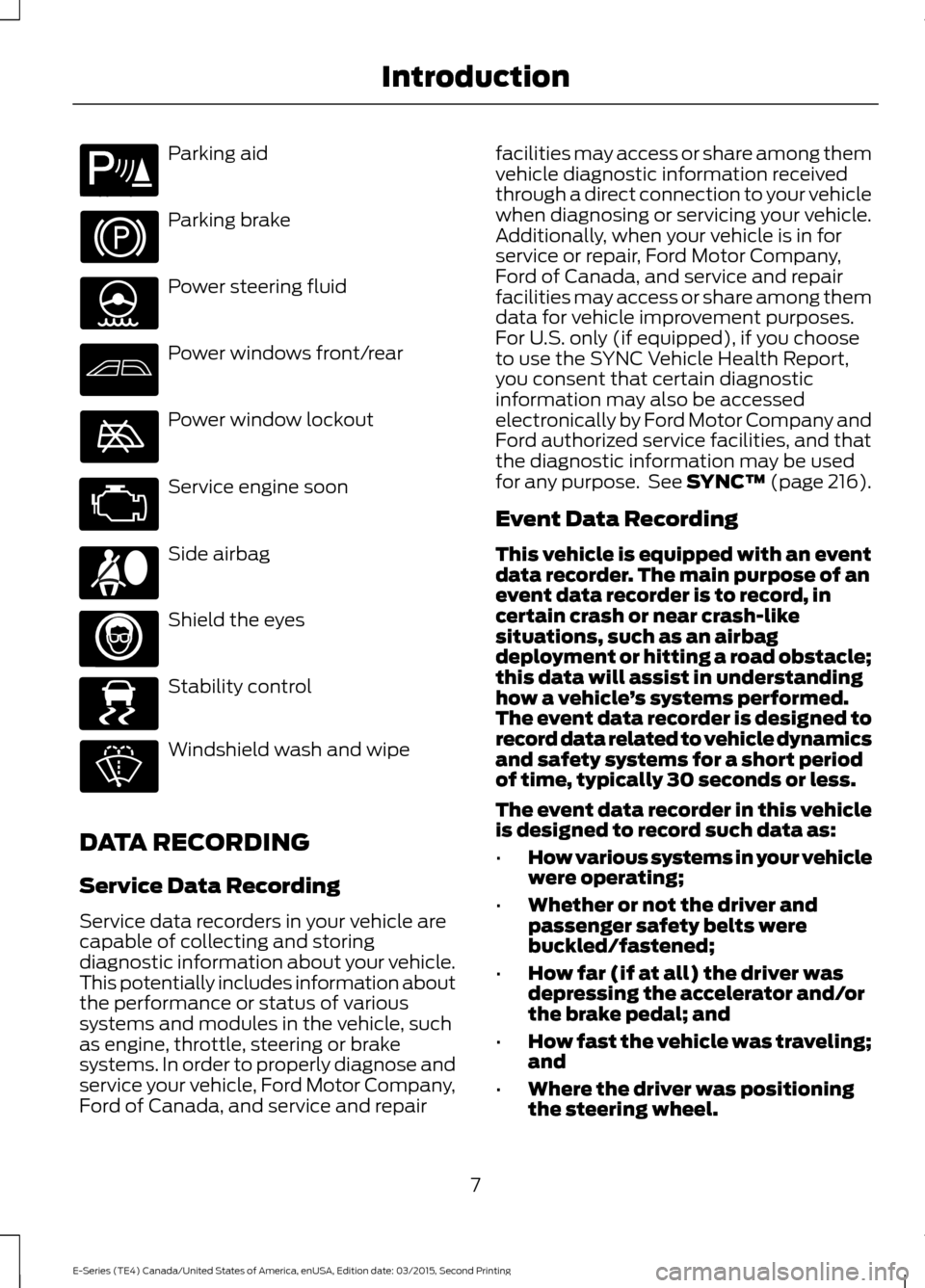
Parking aid
Parking brake
Power steering fluid
Power windows front/rear
Power window lockout
Service engine soon
Side airbag
Shield the eyes
Stability control
Windshield wash and wipe
DATA RECORDING
Service Data Recording
Service data recorders in your vehicle are
capable of collecting and storing
diagnostic information about your vehicle.
This potentially includes information about
the performance or status of various
systems and modules in the vehicle, such
as engine, throttle, steering or brake
systems. In order to properly diagnose and
service your vehicle, Ford Motor Company,
Ford of Canada, and service and repair facilities may access or share among them
vehicle diagnostic information received
through a direct connection to your vehicle
when diagnosing or servicing your vehicle.
Additionally, when your vehicle is in for
service or repair, Ford Motor Company,
Ford of Canada, and service and repair
facilities may access or share among them
data for vehicle improvement purposes.
For U.S. only (if equipped), if you choose
to use the SYNC Vehicle Health Report,
you consent that certain diagnostic
information may also be accessed
electronically by Ford Motor Company and
Ford authorized service facilities, and that
the diagnostic information may be used
for any purpose. See SYNC™ (page 216).
Event Data Recording
This vehicle is equipped with an event
data recorder. The main purpose of an
event data recorder is to record, in
certain crash or near crash-like
situations, such as an airbag
deployment or hitting a road obstacle;
this data will assist in understanding
how a vehicle
’s systems performed.
The event data recorder is designed to
record data related to vehicle dynamics
and safety systems for a short period
of time, typically 30 seconds or less.
The event data recorder in this vehicle
is designed to record such data as:
• How various systems in your vehicle
were operating;
• Whether or not the driver and
passenger safety belts were
buckled/fastened;
• How far (if at all) the driver was
depressing the accelerator and/or
the brake pedal; and
• How fast the vehicle was traveling;
and
• Where the driver was positioning
the steering wheel.
7
E-Series (TE4) Canada/United States of America, enUSA, Edition date: 03/2015, Second Printing IntroductionE139213 E167012 E138639
Page 45 of 319
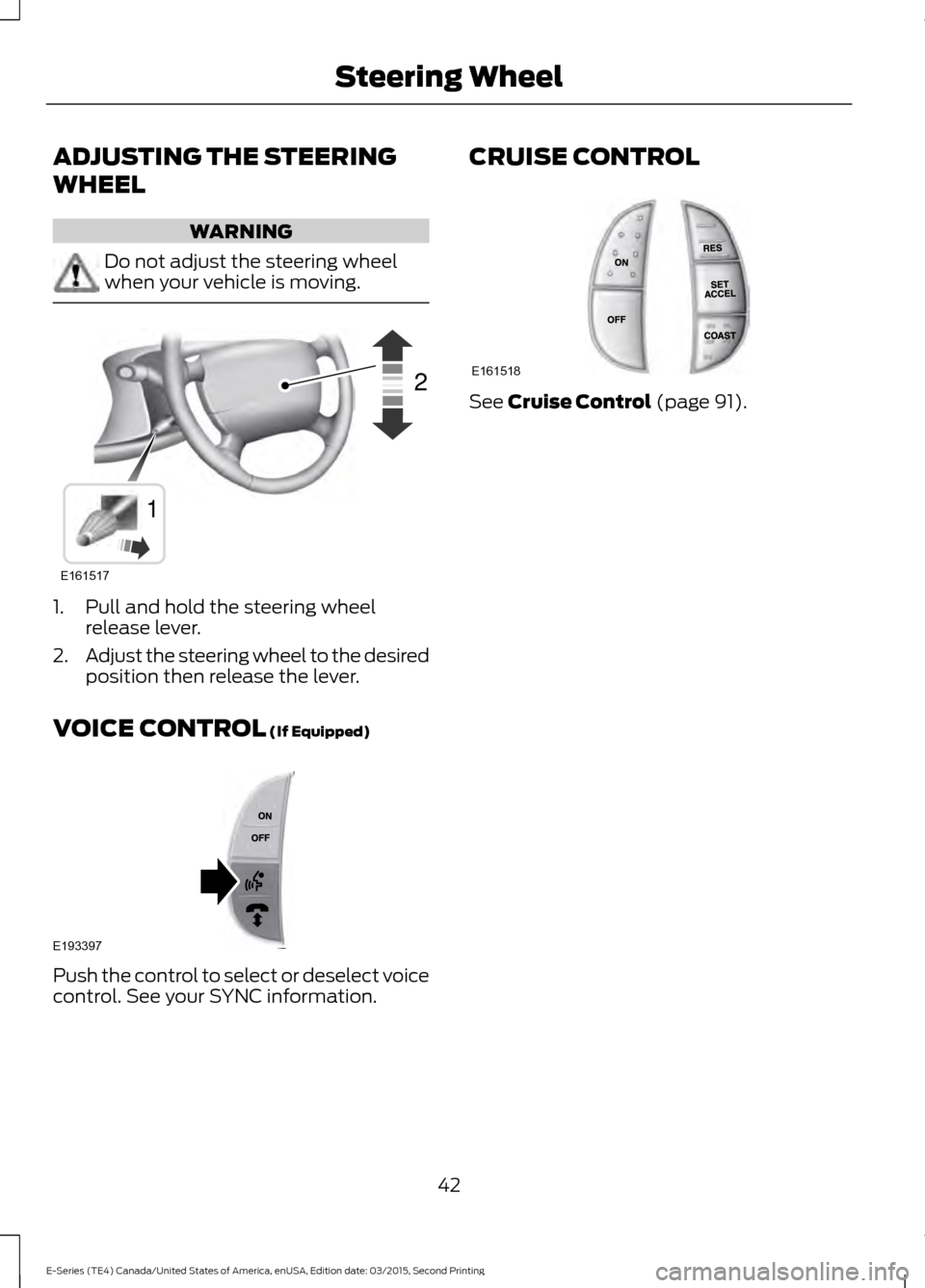
ADJUSTING THE STEERING
WHEEL
WARNING
Do not adjust the steering wheel
when your vehicle is moving.
1. Pull and hold the steering wheel
release lever.
2. Adjust the steering wheel to the desired
position then release the lever.
VOICE CONTROL (If Equipped) Push the control to select or deselect voice
control. See your SYNC information. CRUISE CONTROL
See
Cruise Control (page 91).
42
E-Series (TE4) Canada/United States of America, enUSA, Edition date: 03/2015, Second Printing Steering WheelE161517
12 E193397 E161518
Page 70 of 319
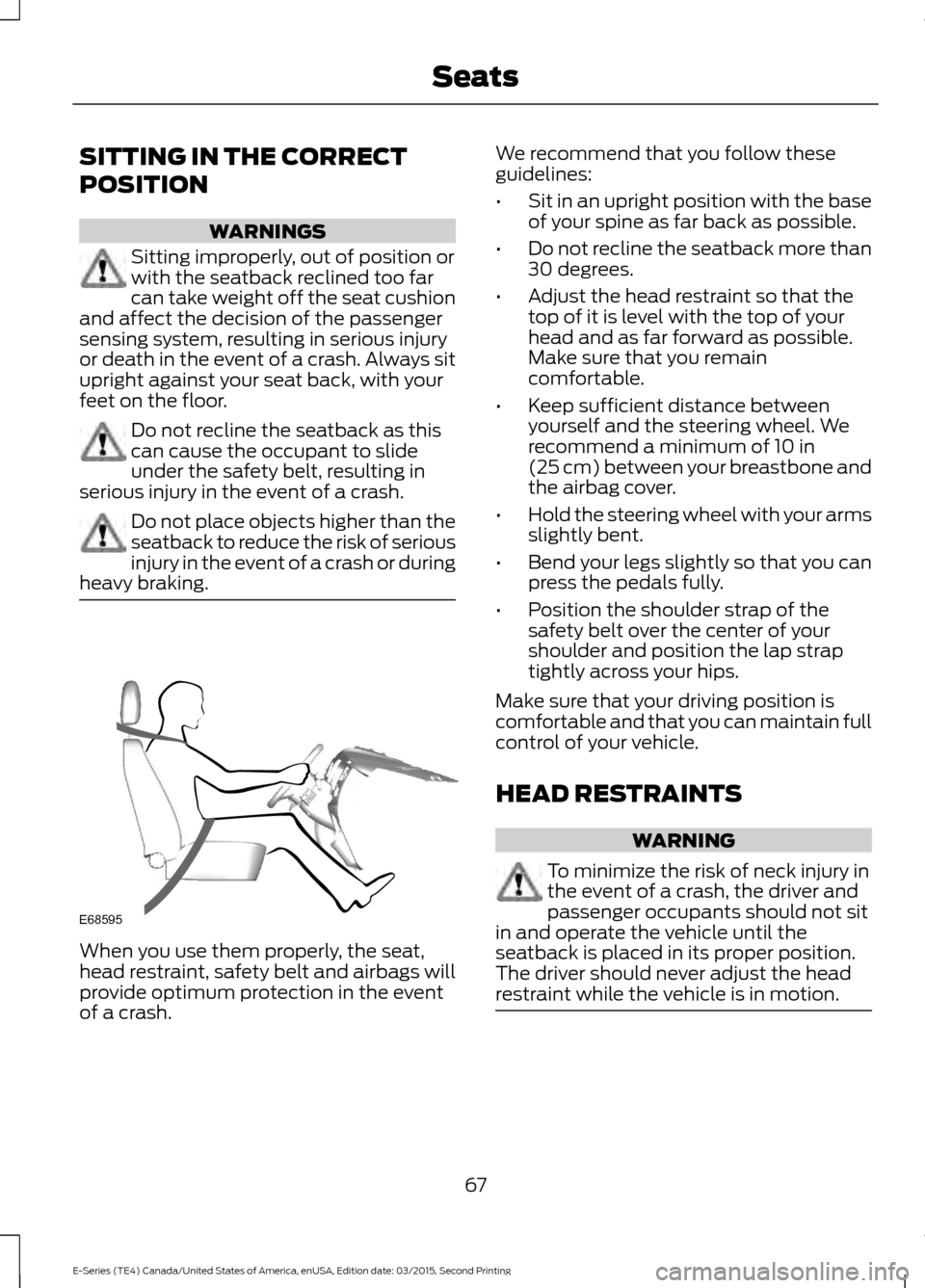
SITTING IN THE CORRECT
POSITION
WARNINGS
Sitting improperly, out of position or
with the seatback reclined too far
can take weight off the seat cushion
and affect the decision of the passenger
sensing system, resulting in serious injury
or death in the event of a crash. Always sit
upright against your seat back, with your
feet on the floor. Do not recline the seatback as this
can cause the occupant to slide
under the safety belt, resulting in
serious injury in the event of a crash. Do not place objects higher than the
seatback to reduce the risk of serious
injury in the event of a crash or during
heavy braking. When you use them properly, the seat,
head restraint, safety belt and airbags will
provide optimum protection in the event
of a crash. We recommend that you follow these
guidelines:
•
Sit in an upright position with the base
of your spine as far back as possible.
• Do not recline the seatback more than
30 degrees.
• Adjust the head restraint so that the
top of it is level with the top of your
head and as far forward as possible.
Make sure that you remain
comfortable.
• Keep sufficient distance between
yourself and the steering wheel. We
recommend a minimum of 10 in
(25 cm) between your breastbone and
the airbag cover.
• Hold the steering wheel with your arms
slightly bent.
• Bend your legs slightly so that you can
press the pedals fully.
• Position the shoulder strap of the
safety belt over the center of your
shoulder and position the lap strap
tightly across your hips.
Make sure that your driving position is
comfortable and that you can maintain full
control of your vehicle.
HEAD RESTRAINTS WARNING
To minimize the risk of neck injury in
the event of a crash, the driver and
passenger occupants should not sit
in and operate the vehicle until the
seatback is placed in its proper position.
The driver should never adjust the head
restraint while the vehicle is in motion. 67
E-Series (TE4) Canada/United States of America, enUSA, Edition date: 03/2015, Second Printing SeatsE68595
Page 89 of 319
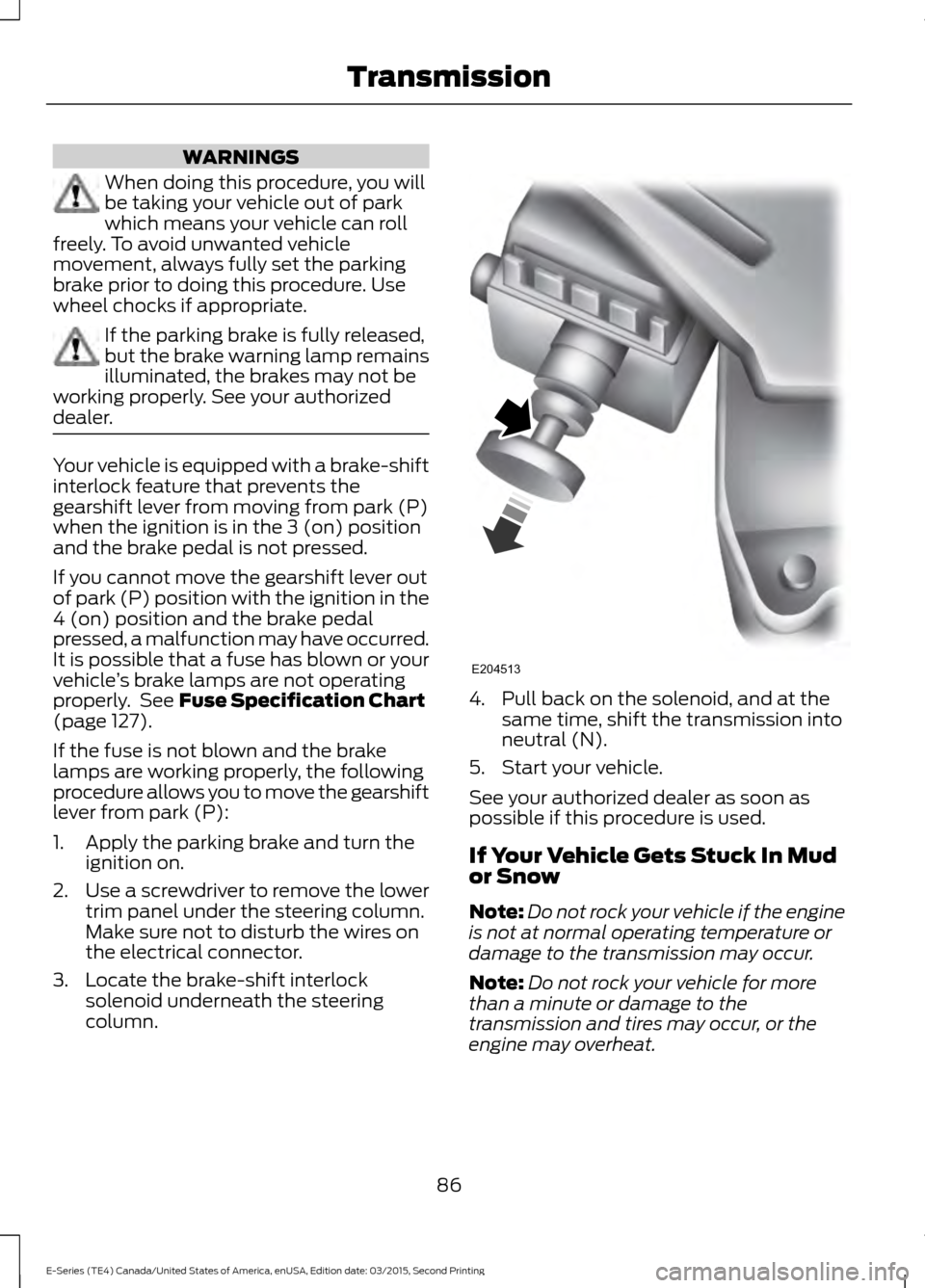
WARNINGS
When doing this procedure, you will
be taking your vehicle out of park
which means your vehicle can roll
freely. To avoid unwanted vehicle
movement, always fully set the parking
brake prior to doing this procedure. Use
wheel chocks if appropriate. If the parking brake is fully released,
but the brake warning lamp remains
illuminated, the brakes may not be
working properly. See your authorized
dealer. Your vehicle is equipped with a brake-shift
interlock feature that prevents the
gearshift lever from moving from park (P)
when the ignition is in the 3 (on) position
and the brake pedal is not pressed.
If you cannot move the gearshift lever out
of park (P) position with the ignition in the
4 (on) position and the brake pedal
pressed, a malfunction may have occurred.
It is possible that a fuse has blown or your
vehicle
’s brake lamps are not operating
properly. See Fuse Specification Chart
(page 127).
If the fuse is not blown and the brake
lamps are working properly, the following
procedure allows you to move the gearshift
lever from park (P):
1. Apply the parking brake and turn the ignition on.
2. Use a screwdriver to remove the lower
trim panel under the steering column.
Make sure not to disturb the wires on
the electrical connector.
3. Locate the brake-shift interlock solenoid underneath the steering
column. 4. Pull back on the solenoid, and at the
same time, shift the transmission into
neutral (N).
5. Start your vehicle.
See your authorized dealer as soon as
possible if this procedure is used.
If Your Vehicle Gets Stuck In Mud
or Snow
Note: Do not rock your vehicle if the engine
is not at normal operating temperature or
damage to the transmission may occur.
Note: Do not rock your vehicle for more
than a minute or damage to the
transmission and tires may occur, or the
engine may overheat.
86
E-Series (TE4) Canada/United States of America, enUSA, Edition date: 03/2015, Second Printing TransmissionE204513
Page 91 of 319
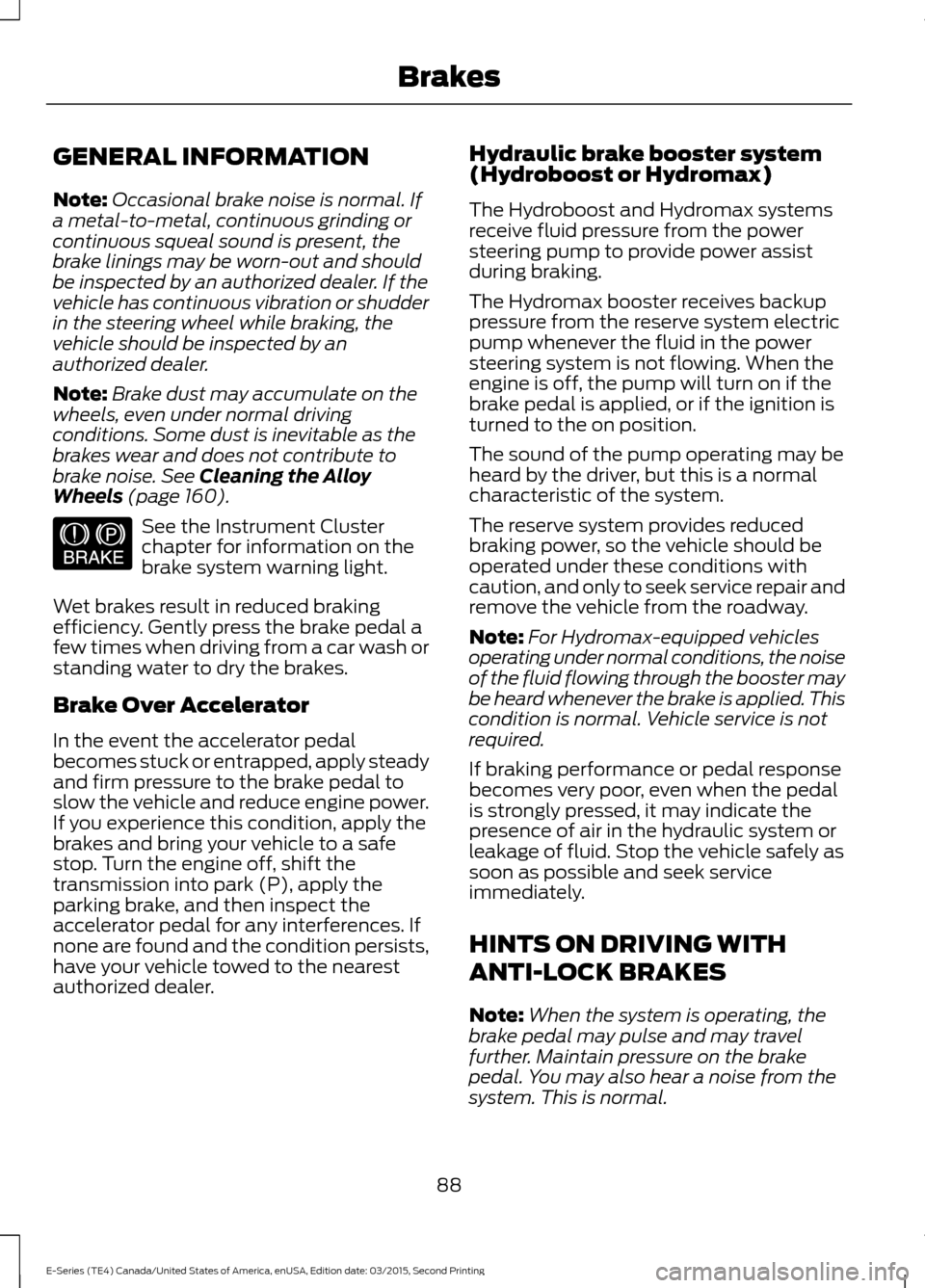
GENERAL INFORMATION
Note:
Occasional brake noise is normal. If
a metal-to-metal, continuous grinding or
continuous squeal sound is present, the
brake linings may be worn-out and should
be inspected by an authorized dealer. If the
vehicle has continuous vibration or shudder
in the steering wheel while braking, the
vehicle should be inspected by an
authorized dealer.
Note: Brake dust may accumulate on the
wheels, even under normal driving
conditions. Some dust is inevitable as the
brakes wear and does not contribute to
brake noise. See Cleaning the Alloy
Wheels (page 160). See the Instrument Cluster
chapter for information on the
brake system warning light.
Wet brakes result in reduced braking
efficiency. Gently press the brake pedal a
few times when driving from a car wash or
standing water to dry the brakes.
Brake Over Accelerator
In the event the accelerator pedal
becomes stuck or entrapped, apply steady
and firm pressure to the brake pedal to
slow the vehicle and reduce engine power.
If you experience this condition, apply the
brakes and bring your vehicle to a safe
stop. Turn the engine off, shift the
transmission into park (P), apply the
parking brake, and then inspect the
accelerator pedal for any interferences. If
none are found and the condition persists,
have your vehicle towed to the nearest
authorized dealer. Hydraulic brake booster system
(Hydroboost or Hydromax)
The Hydroboost and Hydromax systems
receive fluid pressure from the power
steering pump to provide power assist
during braking.
The Hydromax booster receives backup
pressure from the reserve system electric
pump whenever the fluid in the power
steering system is not flowing. When the
engine is off, the pump will turn on if the
brake pedal is applied, or if the ignition is
turned to the on position.
The sound of the pump operating may be
heard by the driver, but this is a normal
characteristic of the system.
The reserve system provides reduced
braking power, so the vehicle should be
operated under these conditions with
caution, and only to seek service repair and
remove the vehicle from the roadway.
Note:
For Hydromax-equipped vehicles
operating under normal conditions, the noise
of the fluid flowing through the booster may
be heard whenever the brake is applied. This
condition is normal. Vehicle service is not
required.
If braking performance or pedal response
becomes very poor, even when the pedal
is strongly pressed, it may indicate the
presence of air in the hydraulic system or
leakage of fluid. Stop the vehicle safely as
soon as possible and seek service
immediately.
HINTS ON DRIVING WITH
ANTI-LOCK BRAKES
Note: When the system is operating, the
brake pedal may pulse and may travel
further. Maintain pressure on the brake
pedal. You may also hear a noise from the
system. This is normal.
88
E-Series (TE4) Canada/United States of America, enUSA, Edition date: 03/2015, Second Printing BrakesE144522
Page 94 of 319
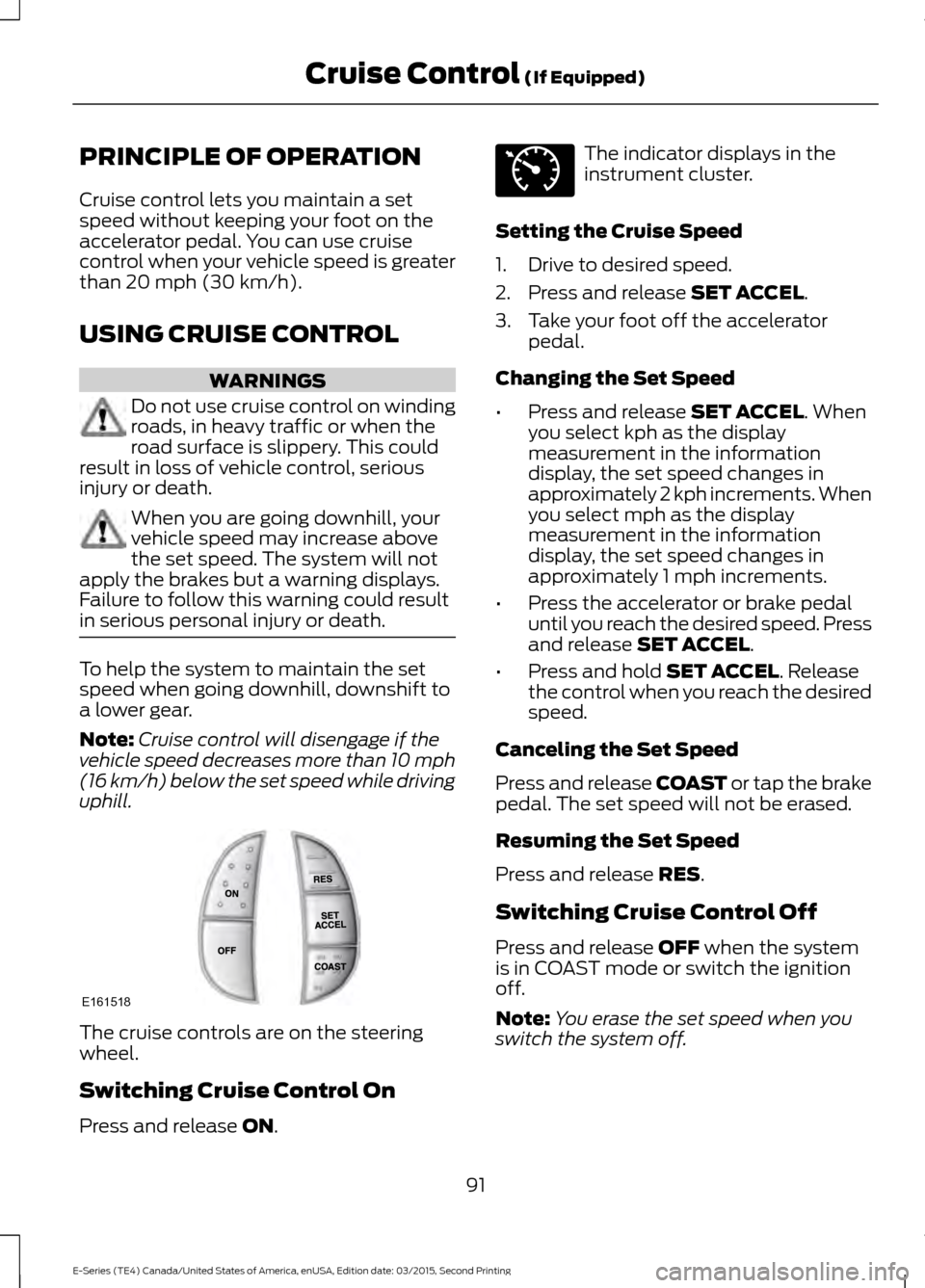
PRINCIPLE OF OPERATION
Cruise control lets you maintain a set
speed without keeping your foot on the
accelerator pedal. You can use cruise
control when your vehicle speed is greater
than 20 mph (30 km/h).
USING CRUISE CONTROL WARNINGS
Do not use cruise control on winding
roads, in heavy traffic or when the
road surface is slippery. This could
result in loss of vehicle control, serious
injury or death. When you are going downhill, your
vehicle speed may increase above
the set speed. The system will not
apply the brakes but a warning displays.
Failure to follow this warning could result
in serious personal injury or death. To help the system to maintain the set
speed when going downhill, downshift to
a lower gear.
Note:
Cruise control will disengage if the
vehicle speed decreases more than 10 mph
(16 km/h) below the set speed while driving
uphill. The cruise controls are on the steering
wheel.
Switching Cruise Control On
Press and release
ON. The indicator displays in the
instrument cluster.
Setting the Cruise Speed
1. Drive to desired speed.
2. Press and release
SET ACCEL.
3. Take your foot off the accelerator pedal.
Changing the Set Speed
• Press and release
SET ACCEL. When
you select kph as the display
measurement in the information
display, the set speed changes in
approximately 2 kph increments. When
you select mph as the display
measurement in the information
display, the set speed changes in
approximately 1 mph increments.
• Press the accelerator or brake pedal
until you reach the desired speed. Press
and release
SET ACCEL.
• Press and hold
SET ACCEL. Release
the control when you reach the desired
speed.
Canceling the Set Speed
Press and release COAST or tap the brake
pedal. The set speed will not be erased.
Resuming the Set Speed
Press and release
RES.
Switching Cruise Control Off
Press and release
OFF when the system
is in COAST mode or switch the ignition
off.
Note: You erase the set speed when you
switch the system off.
91
E-Series (TE4) Canada/United States of America, enUSA, Edition date: 03/2015, Second Printing Cruise Control
(If Equipped)E161518 E71340
Page 95 of 319
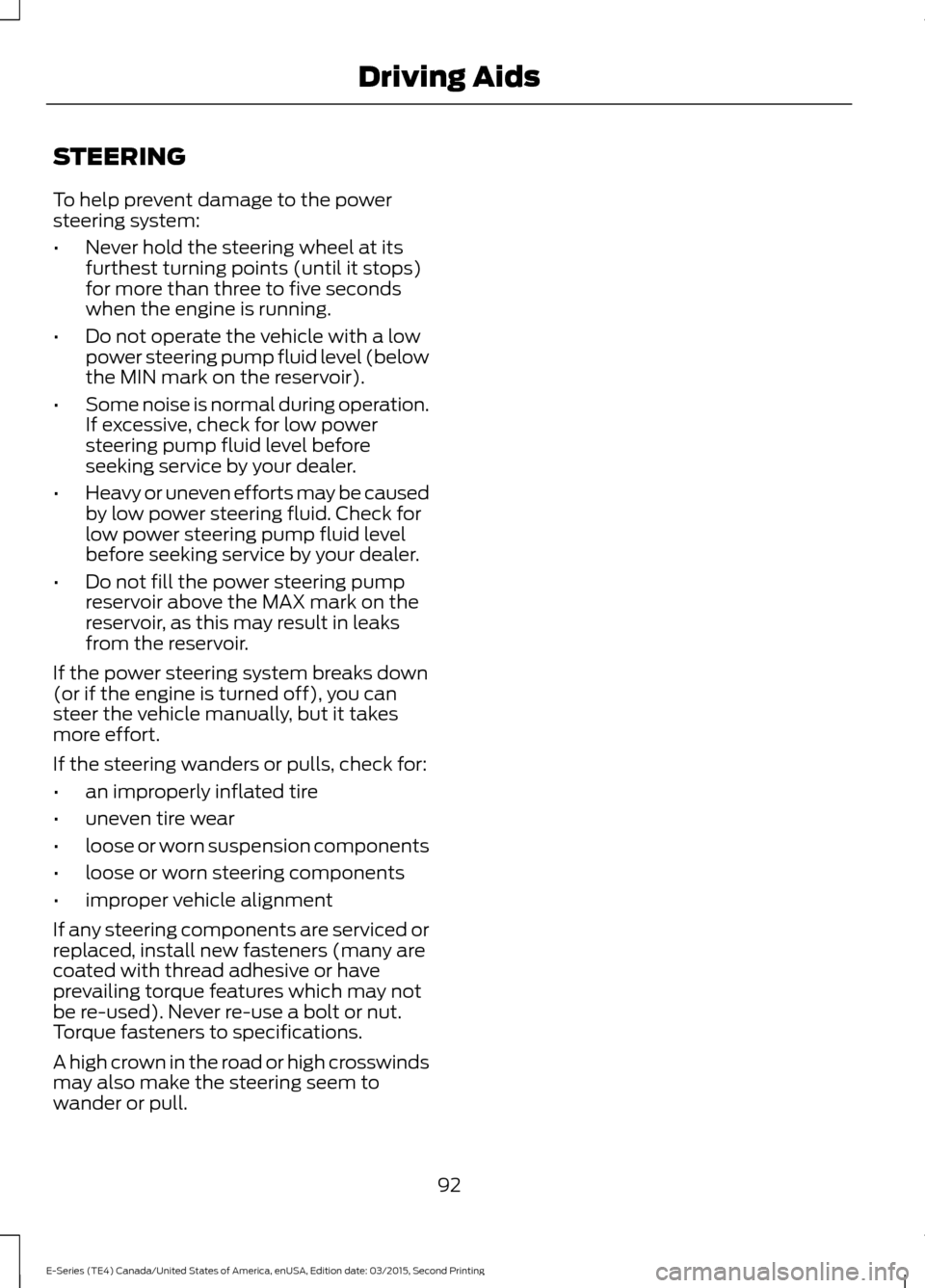
STEERING
To help prevent damage to the power
steering system:
•
Never hold the steering wheel at its
furthest turning points (until it stops)
for more than three to five seconds
when the engine is running.
• Do not operate the vehicle with a low
power steering pump fluid level (below
the MIN mark on the reservoir).
• Some noise is normal during operation.
If excessive, check for low power
steering pump fluid level before
seeking service by your dealer.
• Heavy or uneven efforts may be caused
by low power steering fluid. Check for
low power steering pump fluid level
before seeking service by your dealer.
• Do not fill the power steering pump
reservoir above the MAX mark on the
reservoir, as this may result in leaks
from the reservoir.
If the power steering system breaks down
(or if the engine is turned off), you can
steer the vehicle manually, but it takes
more effort.
If the steering wanders or pulls, check for:
• an improperly inflated tire
• uneven tire wear
• loose or worn suspension components
• loose or worn steering components
• improper vehicle alignment
If any steering components are serviced or
replaced, install new fasteners (many are
coated with thread adhesive or have
prevailing torque features which may not
be re-used). Never re-use a bolt or nut.
Torque fasteners to specifications.
A high crown in the road or high crosswinds
may also make the steering seem to
wander or pull.
92
E-Series (TE4) Canada/United States of America, enUSA, Edition date: 03/2015, Second Printing Driving Aids